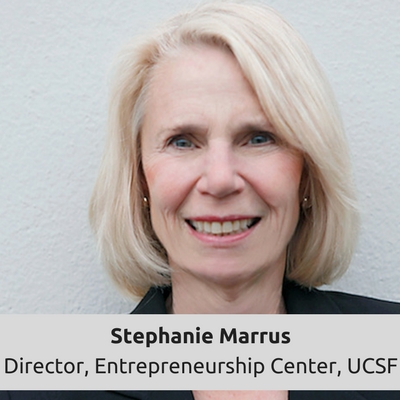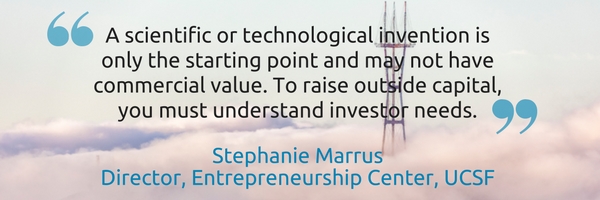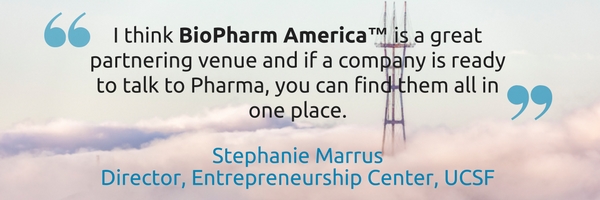From academia to biotech startup, UCSF Entrepreneurship Center Director Stephanie Marrus facilitates the critical link toward success

 How do academic and budding biotech entrepreneurs make the leap from solid science to commercialization? Knowledge, support and connections. This is the mission of the Entrepreneurship Center at UC San Francisco (UCSF), to help launch biotech startup companies out of UCSF technology by exposing them to information and a network of experts and executives from the life science community, including the Silicon Valley ecosystem that is viewed as the world's standard for startups. The key is to expose scientists and clinicians to the business mindset.
How do academic and budding biotech entrepreneurs make the leap from solid science to commercialization? Knowledge, support and connections. This is the mission of the Entrepreneurship Center at UC San Francisco (UCSF), to help launch biotech startup companies out of UCSF technology by exposing them to information and a network of experts and executives from the life science community, including the Silicon Valley ecosystem that is viewed as the world's standard for startups. The key is to expose scientists and clinicians to the business mindset.
“Everything we do is focused on that overarching goal,” said Stephanie Marrus, Director of the UCSF Entrepreneurship Center. “Part of creating successful companies is tapping into that ecosystem and creating connections that didn't really exist before.”
MOLDING ENTREPRENEURS
Marrus came into her unique role at the Entrepreneurship Center from industry. “I had been doing business development in the life science sector as well as bailing out some VC investments that needed to be restructured or sold, working in C-level positions and doing teaching on the side at Berkeley,” said Marrus. “I became involved with the global entrepreneurship scene and spent five years flying back and forth to Russia to teach entrepreneurship, then branched out to other regions including the Middle East, South America, Asia and Europe. I realized how much I enjoyed teaching and mentoring, so when the UCSF position opened up, I came on board.”
The Entrepreneurship Center holds a number of events, workshops and classes and invites Berkeley, Stanford and the Bay Area business community to participate, strengthening the network to benefit UCSF’s startup companies. Programs range from the Entrepreneur’s Club, featuring speakers who recently left academia to start companies, to a Speaker Series featuring CEOs and investors, a digital health mixer that attracts hundreds, a mixer between VCs and entrepreneurs and an invitation-only Founder’s Group. For education, the fall workshop series delves into essential topics such as IP, negotiation skills, team building and pitching.
“Our Startup 101 course is the crown jewel,” said Marrus. Teams self-assemble to work on validating the business potential of a scientific/technical idea and in 12 weeks complete a business plan in the form of a pitch deck and executive summary. The final event features teams delivering their pitch to an audience of investors and the business community.
SUCCESS STORIES
Notable successes coming from the Entrepreneurship Center include a digital health company, Elemeno Health, that was invited into Y Combinator, the country’s premier startup accelerator that accepts less than 2% of applicants. Elemeno is running multiple hospital pilots of its app to improve coordination of the various front line caregivers. Genedit, a CRISPR technology company formed by a PhD student in the joint UCSF/UC Berkeley bioengineering program, raised funding from Sequoia Capital after taking Startup 101. Other companies are working on diagnostics, medical devices and therapeutics that have the potential to be game changers.
“Our portfolio—companies that have been created or influenced by the Entrepreneurship Center— includes 20 companies that have raised an aggregate of USD 59 million between 2013 and 2016,” said Marrus. “This is phenomenal, considering that the Center started from virtually nothing in 2012 when I joined. We have built the premier life science/healthcare entrepreneurship program in the US.”
DEEP LESSONS
In her role, Marrus hears a lot of big ideas from scientists and clinicians who want to commercialize their discovery. “I help them assess whether their idea can be a high potential, scalable business,” said Marrus. “A scientific or technological invention is only the starting point and may not have commercial value. To raise outside capital, you must understand investor needs. You need product/market fit, a viable value proposition, a sizable market and a team. We teach them to talk to potential customers before developing the technology—who is the buyer and what do they think of your idea? Our life science business is extremely complex because the buyer is often not the user.”
Marrus considers a sufficient market opportunity as one that exceeds the USD 500 million threshold. And a company must include a good team. “They need exposure to the business world and to understand the investor perspective,” said Marrus. “And to come away with the impression that yes, they can do it, they can create a real business.”
The process weeds out those who discover that, as great as their technology is, they still need to get to proof of concept or that market demand is insufficient. “There is a lot of deep learning that goes on in my class, and it sometimes results in the realization that the entrepreneur may not have a company,” said Marrus. “We make business help available to them through mentorship and bringing MBAs into the network. We push them to interview buyers, such as Pharma or an insurer, for feedback.” Many companies find their initial funding through the USG’s Small Business Innovation Research (SBIR) awards.
“Post Startup 101, I continue working with anyone who is serious to help them reach their goal,” said Marrus. “I call it a pre-accelerator program, but it’s essentially me making the right connections and mentoring the startup. I’ll facilitate introductions to accelerators and investors, and work with the company on strategy and enhancing the pitch. I’ll invite the company into our Founders Group, an important peer network for startup founders.”
ACCESSING CAPITAL
Beyond government award programs, it can be a challenge for budding entrepreneurs to access the initial capital required to start a company. The availability of very early stage capital is slim, and POC is a minimum requirement to open most VC doors. Marrus tries to help UCSF entrepreneurs uncover alternative, less visible sources of capital.
“Frankly, it’s difficult,” said Marrus. “This is one of the benefits of BioPharm America™. It provides them with insight into the market, direct contact with Pharma executives who can provide market feedback and exposure to funding sources. Understanding that the main role of the CEO is to raise money is a big surprise. Our potential entrepreneurs think that their job is to enhance the science and the rest will follow, until we introduce them to reality. Networking is an essential skill.”
“I think BioPharm America is a great partnering venue and if a company is ready to talk to Pharma, you can find them all in one place,” said Marrus.
FROM PITFALLS TO POTENTIAL
The most easily avoided pitfall experienced by scientist/clinical entrepreneurs is not understanding their market, according to Marrus. During customer discovery, you engage in listening to the marketplace.
“You can spend years refining your technology only to find that nobody will pay for it,” said Marrus. “Learning what the market values is one of the most important skills we can teach.” With that information, an entrepreneur will understand if the idea can become a business. If not, it’s time to pivot to a new concept that addresses the market need.
“I love working with our entrepreneurs,” said Marrus. “It’s very rewarding to help our scientific/technical people at “business Ground Zero” and provide them with business smarts. I am amazed at how much they absorb in a 12-week class, enough to interact appropriately in the business and investment community. I feel fortunate to be able to help these outstanding young people and watch them mature into startup CEOs. We certainly have all the brain power we need at UCSF; my job is to channel that power into a business that can impact human health.”



